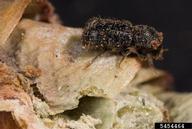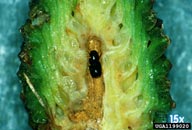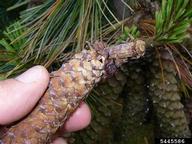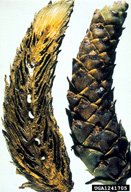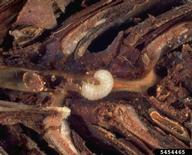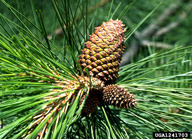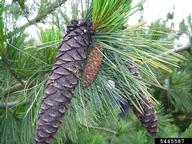Lodgepole cone beetle
Conophthorus ponderosae Hopkins (Coleoptera: Curculionidae, Scolytinae)
Orientation to pest
Western cone beetles (Conophthorus spp.) were historically described based on their principal host trees. The sugar pine cone beetle (Conophthorus lambertianae Hopkins) was described from Pinus lambertiana Douglas, but it was later declared a junior synonym of Conophthorus ponderosae Hopkins, which was formerly known as the ponderosa cone beetle, but is now referred to as the lodgepole cone beetle (Wood 1977). Later work based on similarities among beetle cuticular hydrocarbons (Page et al. 1990), however, suggested that the sugar pine-feeding population of C. ponderosae may indeed be a separate species (the former C. lambertianae), but it was not formerly reinstated taxonomically. The possible validity of a sugar pine-feeding species is consistent with recent DNA studies that shown that there likely have been more speciation events in this genus than were formerly suspected. But these appear to have been driven by geographic isolation, not affinity to particular host species (Cognato et al., 2005), although sometimes the two go together. The ponderosa cone beetle (C. ponderosae in the wide sense), as discussed here, is composed of several populations as noted above, whose relatedness is not certain. The population associated with ponderosa (Pinus ponderosa Douglas ex C. Lawson), lodgepole (Pinus contorta var.latifolia Douglas), and Jeffrey (Pinus jeffreyi Balf.) pines is found from Washington to California, and in Arizona and New Mexico. The population associated with sugar pine (Pinus lambertiana Douglas) is found in California, Nevada and Oregon, where it feeds mostly on P. lambertiana and sometimes on western white pine (Pinus monticola Douglas ex D. Don).
For purposes of this presentation, we discuss C. ponderosae in the wide sense, inclusive of C. lambertianae. Regardless of their specie-level status, the biologies of these populations are very similar. In broad terms, their biology is similar to that of the white pine cone beetle (Conophthorus coniperda [Schwarz]) in the eastern United States. Adults bore into the pedicles of immature, second year pine cones in the spring and dig a tunnel along the length of the cone, where the female deposits her eggs. Larvae feed on the scales, seeds, and tissues of the cone. Pupation occurs within the cone and adults overwinter on the soil in fallen cones. For the sugar-pine feeding population ("C. lambertianae"), adults emerge from cones in the fall and move to twigs, boring into them to feed, where they remain over winter.
The C. ponderosae population associated with sugar pine is the most destructive of the western Conophthorus cone beetles. It sometimes destroys up to 75% of sugar pine seeds in some years, making it an important pest in sugar pine seed orchards. Similarly, the C. ponderosae population associated with western white pine in British Columbia, Washington, and Idaho has caused important losses in seed collection stands and seeds orchards of that species. The other populations of C. ponderosae have similar effects on other species of pines in seed orchards, but the typical rate of seed destruction is lower.
Hosts commonly attacked
The lodgepole cone beetle, in the wide sense, attacks ponderosa (P. ponderosa), lodgepole (P. contorta var. latifolia), Jeffrey (P. jeffreyi), sugar (P. lambertiana), and western white (P. monticola) pines.
Distribution
The lodgepole cone beetle, in the wide sense, is found from British Columbia to California, as well as in Idaho, Nevada, Arizona and New Mexico.
Images of lodgepole cone beetle
| Figure 1. Adult of lodgepole cone beetle, Conophthorus ponderosae | Figure 2. Adult cone beetles (Conophthorus sp.) tunnel in pine cones and their larvae feed on the immature seeds and other tissues | Figure 3. Pitch tube of Conophthorus ponderosae at base of cones in western white pine (P. monticola) at site of adult entrance |
| Figure 4. Internal appearance of pine cones infested by larvae of lodgepole cone beetles | Figure 5. Late instar Conophthorus ponderosae larva exposed in a dissected western white pine (P. monticola) cone | Figure 6. Reduced size of cones of ponderosa pine (left) and western white pine (right) infested by the lodgepole cone beetle compared to the larger, normal cones. | |
Important biological control agents related to this pest species
Little is known of the natural enemies of popluations of lodgepole cone beetle. But larvae of the population found on sugar pine ("C. lambertianae") are attacked in the cone by the bethylid wasp Cephalonomia utahensis Brues. Adult beetles are attacked by both the predatory clerid Enoclerus lecontei Wolcott and are parasitized by the pteromalid wasp Tomicobia tibialis Ashmead.
Web links for information on lodgepole cone beetle
- Biological Control Fact Sheet on BarkBeetles.org | University of California
- Pest Leaflet No. 11: Cone and Seed Insects | Forest Genetics Council of British Columbia
Articles
- Wood, S. L. 1977. New synonymy and new species of American bark beetles (Coleoptera: Scolytidae), part V. Great Basin Naturalist 37: 383-394.
- Page, M., L. J. Nelson, M. I. Haverty, and G. J. Blomquist, G. J. 1990. Cuticular hydrocarbons of eight species of North American cone beetles, Conophthorus Hopkins. Journal of Chemical Ecology 16: 1173-1198.
- Furniss, M. M. 1997. Conophthorus ponderosae (Coleoptera: Scolytidae) infesting lodgepole pine cones in Idaho. Environmental Entomology 26: 855-858.
- Bennett, R. 2000. Management of cone beetles (Conophthorus ponderosae, Scolytidae) in blister rust resistant western white pine seed orchards in British Columbia. Seed and Seedlings Extension Topics 12: 16-18 (available from http://www.for.gov.bc.ca/hti/publications/newsletters/Vol1201Aug20.pdf.
- Cognato, A. I., N. E. Gillette, R. Campos Bolaños, and F. A. H. Sperling. 2005. Mitochondrial phylogeny of pine cone beetles (Scolytinae, Conophthorus) and their affiliation with geographic area and host. Molecular Phylogenetics and Evolution 36: 494-508.
